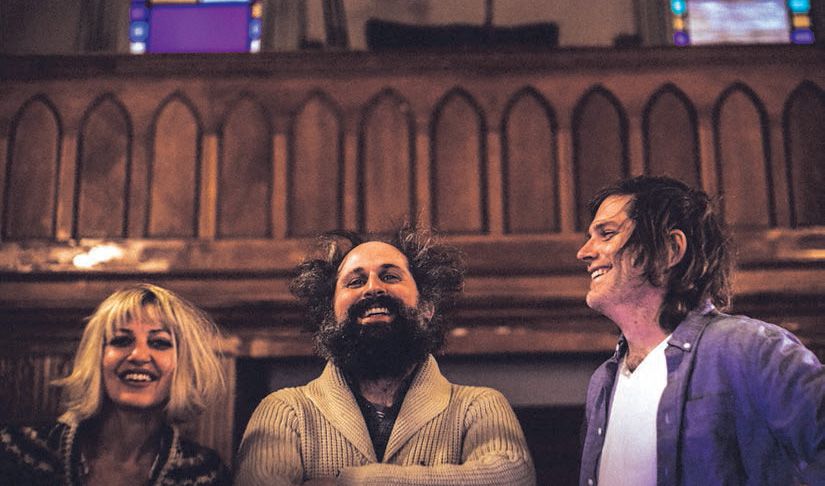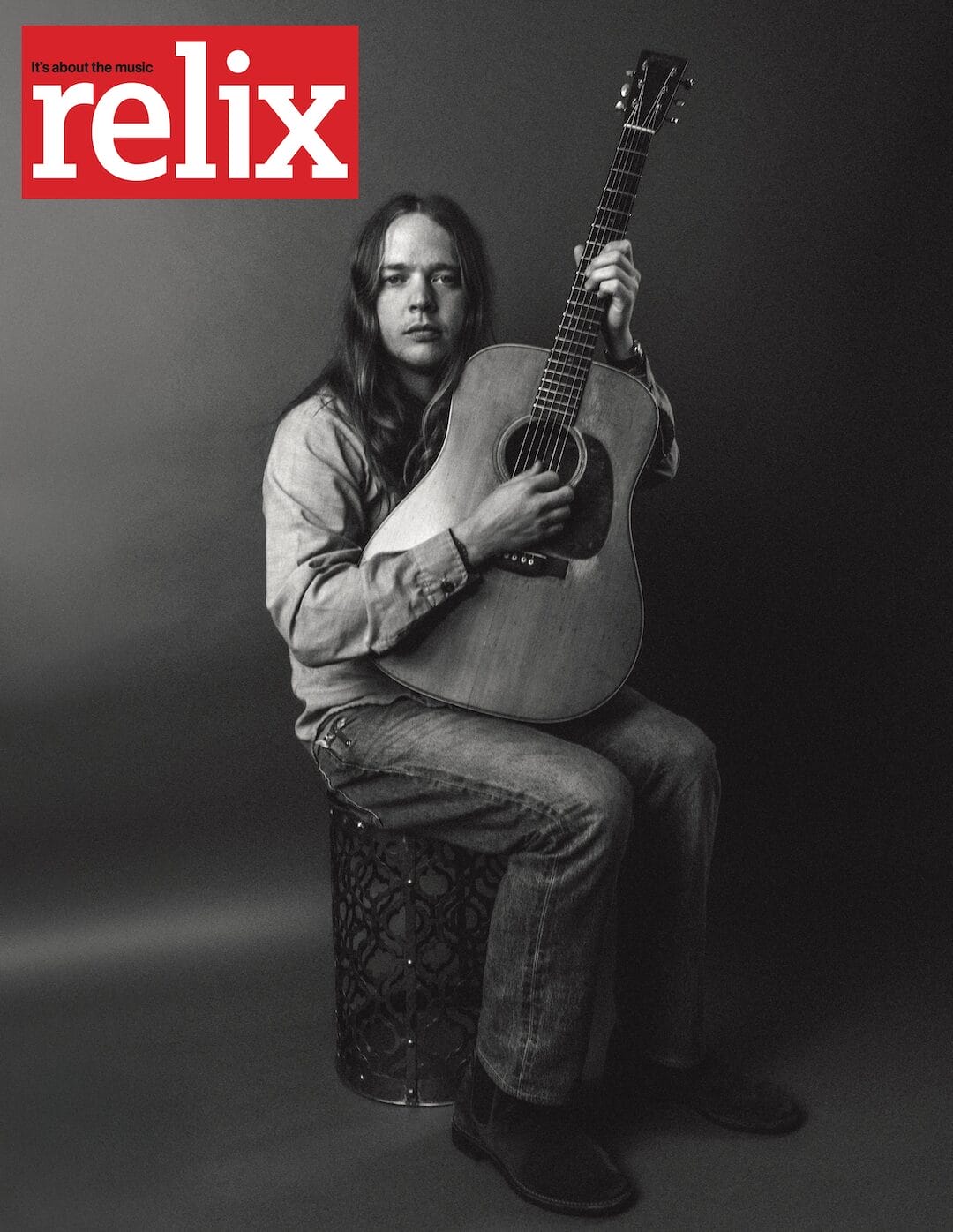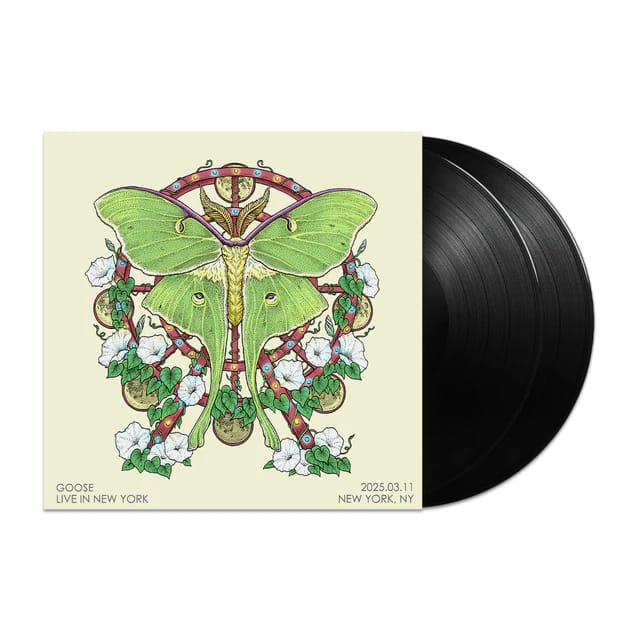Track By Track: Bonny Light Horseman’s Eponymous Debut

In Early 2018, I had the first few little flashes in my brain,” Eric D. Johnson recalls as he shares the origin story of Bonny Light Horseman, the new celestial folk trio that teams the Fruit Bats creator with Josh Kaufman (Bob Weir, Josh Ritter, The National) and Anaïs Mitchell (whose long-gestating Hadestown project won the 2019 Tony for Best New Musical). “I decided that I’d like to do a collaborative thing because I haven’t done that in a really long time. I also wanted to do folk music again, which I hadn’t done in a while, and I knew that I wanted to do something with Josh Kaufman, who’s been a good friend for a long time.
“Right around then, Anaïs tagged me on Twitter, although we had not met,” he adds. “She gave me a little shout out for Fruit Bats, which was really sweet, and I was just starting to get familiar with her work. Social media can be useful for that kind of stuff, when there’s somebody cool who thinks you’re cool. Then, all of a sudden, I was talking with Kaufman and he said he’s doing this thing with her. I was like, ‘I want to come along for that ride.’ I went out to New York to work with them in a writing capacity. They were working on this unnamed semi-conceptual project and I crashed the party, basically.”
Kaufman adds, “Eric says he invited himself, but it was a conversation. Anaïs and I had met through a mutual musician friend named Ray Rizzo. Ray and my wife, Annie [Nero], do these shows called The Three Ring Bender [at Threes Brewing in Brooklyn]. Ray was organizing one with Anaïs to play some songs from Hadestown, which, at the time, was just coming out of being off-Broadway. I met her, heard her and played with her, almost all at the same time, and I was floored. We got to talking afterward about some old English songs and she was like, ‘You know, we should get together and work on some music.’
“Things moved quickly from there as Aaron Dessner, who I’ve worked with for many years, invited me to join him once again at the festival he organizes with Justin Vernon called Eaux Claires. In past years, I’ve hopped around from stage to stage to do different things for different people. He had asked me if there was anything that I wanted to focus on, and I had told him about this project with Anaïs. He was like, ‘Oh, that sounds great. What’s it called?’ But I didn’t know; it didn’t have a name.”
What it did have was a third member as Johnson joined the pair at the event. The trio then received an invitation from Vernon and Dessner’s 37d03d collective to take part in a week-long artist residency in Berlin, where the three musicians recorded a number of tracks at a former East German radio station, now called the Funkhaus, alongside Michael Lewis, JT Bates, Lisa Hannigan, Vernon, Dessner and others. Then, in January 2019, Johnson, Mitchell and Kaufman traveled to Dreamland Studios in Woodstock, N.Y., to complete Bonny Light Horseman, which shares an album name, song title and band sobriquet.
Bonny Light Horseman
ANAÏS MITCHELL: I’ve loved this song for years; I first heard it live, when I heard a friend sing it, and then I discovered the Nic Jones version, among others. A lot of versions of it are full of military imagery, cannons, armies and so on, but we found it moving to leave out the heavy artillery and just sing about these birds in flight—this young woman’s longing to fly like a bird to the resting place of her beloved. We left a ton of space for music, and this is one of the first songs we recorded in Berlin—the room was just full of people. What you hear over all that space at the top of the song is a room full of people aligning chakras before we launched into the song.
ERIC D. JOHNSON: It’s a traditional folk song from the Napoleonic Wars in the early-19th century. We eventually named our band after it. There’s a very short list of bands who have a song that’s also their band name, like Big Country and Bad Company. We just thought that song was emblematic of the whole picture.
The title track is the mission statement of the record in a way, conceptually. These are timeless love songs, and it’s a truly hopeless love song sung from the perspective of someone whose lover has gone to war as a light horseman, sort of like infantrymen or early guerilla warriors. They weren’t on the cavalry line; they were off on their own in the woods. There’s something romantic about it and, eventually, the name of the song became the name of the band.
Deep in Love
EJ: I brought this in when we were recording. It was a Fruit Bats sketch that I had been working on for the Gold Past Life album. I didn’t want to come empty-handed to the recording session. So I brought it to Josh and I was like, “I got this thing. It’s just these chords and this melody,” and I played him a little bit of it. Then Josh picked up this lyric book of folk songs from the British Isles and was like, “Dude, read these lyrics over those verse melodies.” It plugged in perfectly; the lyrics just went with the chorus I had already written. I think we shaved off a verse or two because it’s an old Welsh folk song with like 100 verses.
AM: This one didn’t exist until our sessions in Woodstock. The music for this song started its life as a Fruit Bats sketch. Eric and Josh were messing around with the text of a trad song called “Deep in Love,” which seems to share a lot of imagery with “The Water Is Wide/Waly Waly.” In our earliest shows, we were covering the Tim Buckley song “Buzzin’ Fly,” and this song seemed to access that same free-wheeling romantic spirit.
The Roving
EJ: The recording process in Berlin was a beautifully chaotic series of sessions that I barely remember. Then we sewed up the record-making process in Woodstock. When we got there, we needed a few more tunes to add into the mix. We only had two days and we had to pack in a lot. It was two 12-hour days that went deep into the night. Both “The Roving” and “Deep in Love” were recorded at like 1 a.m. I think they’re both two-take songs, and they might be two of my favorite songs on the record. They’re emblematic of what this is about. I love how modern “The Roving” sounds, almost like a summer romantic comedy teen movie plot, if you listen to the lyrics. But they’re like 500 years old, which points out how simply timeless the subject matter is.
AM: Josh came to us with the idea for this music. Lyrically, this one borrows text from the traditional songs “Loving Hannah” and “Courting Is a Pleasure,” and, maybe, “Handsome Molly.” I love that lyric about “the roving of her eye,” the way it makes sense to lovers across hundreds or even thousands of years.
JOSH KAUFMAN: Anaïs and I were writing it while we were kind of rehearsing it to record it at like 2 a.m. The lyric originally was “Loving Hannah” and then Anaïs was like, “I don’t know if I like singing Hannah. What about Annie?” Eric and I are both married to Annies. So we were like, “I think this is the right way to go here.”
Flipping it so that Anaïs is the narrator, with lyrics like “I think of loving Annie/ Wherever she may be,” brings the song into the time that we’re living in now in such an honest way.
Jane Jane
EJ: This song is a great way to illuminate something I find interesting in this band. We’re approaching folk music from two different directions. I wouldn’t say three, because Josh and I have very similar tastes and a very similar background in terms of how we came to folk music. We’re both Deadheads, we both love mid-period Byrds, and we both love British psych folk like the Incredible String Band and Fairport Convention. Our folk knowledge is all coming through that filter. Anaïs has bonafide folk knowledge not just from her own career, but from growing up. She knows the deep, old stuff.
“Jane Jane” was a song that I knew through Tia Blake. It’s more of a hippie-folk record [1971’s Folksongs & Ballads]. Anaïs knew it because the Tia Blake song is actually a mashup of the song “Jane Jane” and a Christmas song called “Go Where I Send Thee,” which Anaïs knew because she actually sang that at Christmas. I was not in a family hip enough to sing rad, old folk songs at Christmas. We listened to The Carpenters album. She had never heard it mashed up with “Jane Jane” like that, so that is a direct homage to the Tia Blake version of that song.
Like many songs on this record, it was not intended to be a duet; it just sort of worked out that way. It feels really good as a duet—the way those verses and choruses overlap with Anaïs and I trading lines, and then it goes into that big harmony.
Blackwaterside
JK: Anaïs and I had been listening to the Bert Jansch version on the way to Berlin, so I was sort of sweating that guitar part, which is so cool. It’s the thing that Zeppelin took [for “Black Mountain Side” on their debut record].
I loved the track but, when we got to Berlin and I heard Eric singing over a minor five chord, I thought, “What if we simplify the whole song and just made it more of a meditation?” Then it became this conversation between this man and woman. It’s a classic old English song; you hear Sandy Denny or Bert Jansch do it. We wanted to put our own spin on it and, once we found this conversational way of approaching the song, we found our own truth there.
AM: When we arrived in Berlin, I was obsessed with working up a version of this trad song, which takes inspiration from the Anne Briggs and Fairport [Convention] versions, as well as, randomly, the Ewan MacColl song “First Time Ever I Saw Your Face.” We chose to sing it as a duet, which I’ve never heard before, but it made a lot of sense, as there are these two distinct characters. We also had two-thirds of The Staves, plus Lisa Hannigan, in the room and they sang that beautiful, haunting wordless refrain. It’s hard to perform this one without them.
Magpie’s Nest
JK: I had the music for a little while. Once I got into that tuning, I left a guitar parked in my apartment so that I could fumble around on it. I also had “The Magpie’s Nest,” an old English song that I’d found the lyrics to. I moved them around a little bit and made them work over this new music that I was excited about. Then I put it aside.
A bit later, I was on a trip to London and went to see Sam Amidon and Beth Orton, who took us on this beautiful walk over the Hampstead Heath. I was like, “What is that bird over there?” And Beth was like, “Oh, that’s the magpie.” Then she just started reciting this Magpie poetry. I was like, “Oh, yeah, that song,” and I remembered it again.
EJ: We really wanted to have Josh sing the lead vocals. He’s a great singer and you never get to hear him. But he really wanted me to sing lead and it came out that way. It was a great JT Bates drumming song. When I’m recording, I like walking down a path that I didn’t originally think I was going down. In this case, it seems like a traditional folk song but, if you listen to the end, it’s got this groove to it, which we realized is the groove to “All Night Long” by Lionel Richie. It became sort of a centerpiece—a little groover—on the record, which is cool. We want somebody to do a mashup of “Magpie’s Nest” and “All Night Long.”
Lowlands
AM: This was the first song Josh and I started working on. What’s fascinating is there are two strains of Lowlands songs. There’s a collection of them from the British Isles that are essentially ghost stories; the speaker (male or female) is visited by their lover in a dream, and then comes to realize that their lover is dead (usually drowned). In America, though, there’s a collection of Lowlands songs that are stevedore work songs. Ours is a mash-up, with a lover dreaming of, and longing for, her lover working offshore.
Mountain Rain
AM: We were excited to explore some John Henry imagery in this one, which has a lot of our own text, as well as some from the John Henry songbook and “Been All Around This World.” MC Taylor of Hiss Golden Messenger wrote a stanza for it, too. What a powerful message about capitalism this is—this steel-driving man racing against a machine until his heart finally bursts. The digging of a tunnel— “Never did see the light at the tunnel’s end”—breaks my heart. We recorded this very quickly in Berlin, and Christian Lee Hutson, who is the coolest dude in the universe, played a bit of acoustic guitar on it.
JK: This was a piece of music that I had that Eric and Anaïs really connected to. We were always humming along with the top line of the guitar part, but we couldn’t find a song to go with it. Anaïs came out with Josh Ritter on an European tour and was opening up shows, maybe a year and a half ago. She and I were working on some of our little folk songs and we had been messing around with the idea of the John Henry myth. We couldn’t really find it; although we found a couple of things that we liked.
From that tour, I went on a Hiss Golden Messenger tour. And Mike Taylor is a never-ending well of knowledge when it comes to old songs. I played him what we had, and Mike was like, “I hear this song, and I hear this sadness and I hear the truth in it.” Then he went into his hotel room and, five minutes later, I got a text from him, like, “This might work for a first verse?” And it was the first verse. It was kind of amazing.
Bright Morning Stars
JK: “Bright Morning Stars” is an old Appalachian song that I learned from the Jerry Garcia Acoustic Band. But Anaïs used to sing it with her family. I like the reharmonization that we did. Justin Vernon is singing the first verse on that cut.
“Bright Morning Stars” just has some magic to it. In terms of recording live, I’m not a purist, but there is something beautiful about recording without headphones. You really don’t get it much anymore. There’s something kinda sneaky about it. You’re not in headphones, there are no overdubs and you’re not going back over the take. There is something maybe a little less measured there. You open up the mic and there’s bleed everywhere, so everyone is kind of relying on each other and playing together. But in a way, again, you’re not even thinking about it that way because you’re just in a room playing. These recordings have something that you don’t really get a lot these days, especially in the world that it’s coming from. A lot of indierock collaborations are pretty dark and guarded, emotionally. This stuff doesn’t feel that way to me.
10,000 Miles
AM: I’ve loved many versions of this song, including a related one called “The Lass of Loch Royal” that I heard sung by Kelly Joe Phelps. It’s just unbearably romantic to me. We recorded this late at night in Woodstock, and I just loved being able to sing it as a duet and just really sing our hearts out on it.
EJ: In my brain, “10,000 Miles” lives alongside “The Roving” and “Deep in Love,” for some reason. There’s a little world within a world with those three songs. I remember doing that one kind of late too. I have a real soft spot for that song. It’s so goopy, in an awesome way. The chorus is over-the-top in how romantic it is and how dramatic it is. I think of it as a folk version of an ‘80s love theme from a movie or something. I really love singing this song with Anaïs because I don’t have a lot of songs, even with Fruit Bats, where I go for it vocally. But there is something so romantic and theatrical with this one. It comes from a different place, and it’s one of the most unique songs that I get to sing.



















